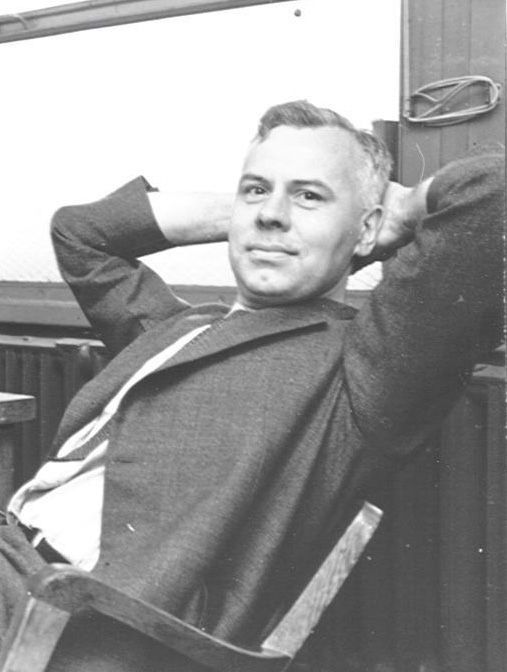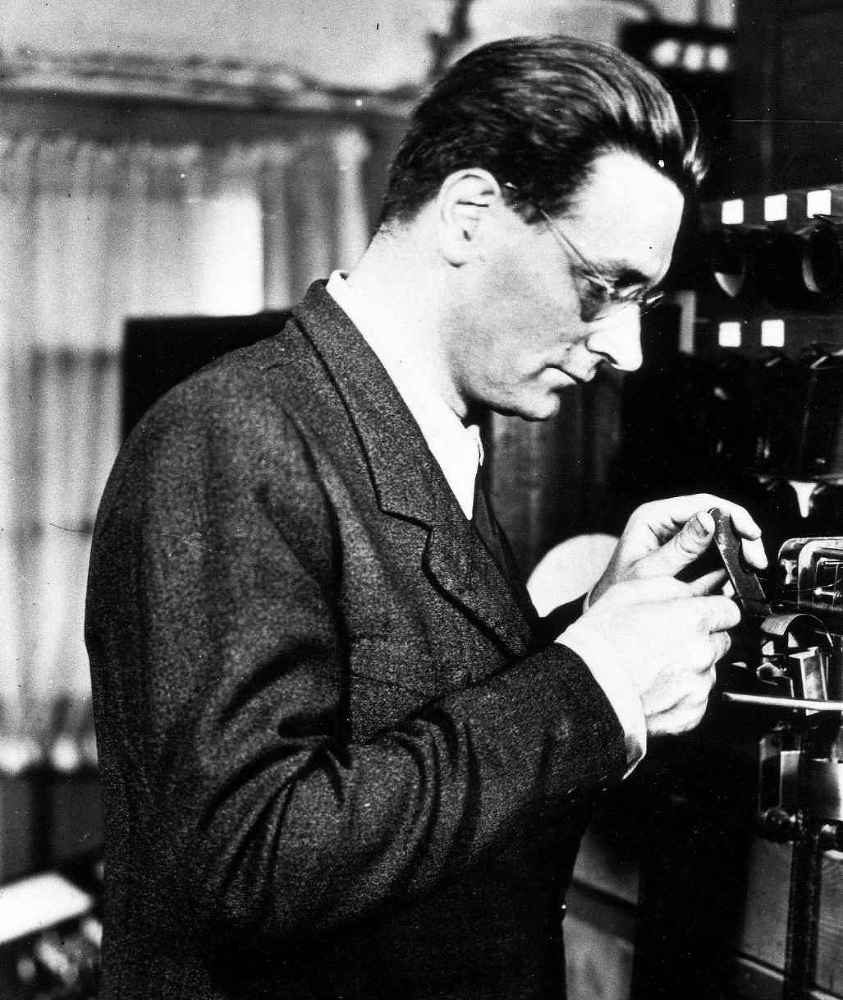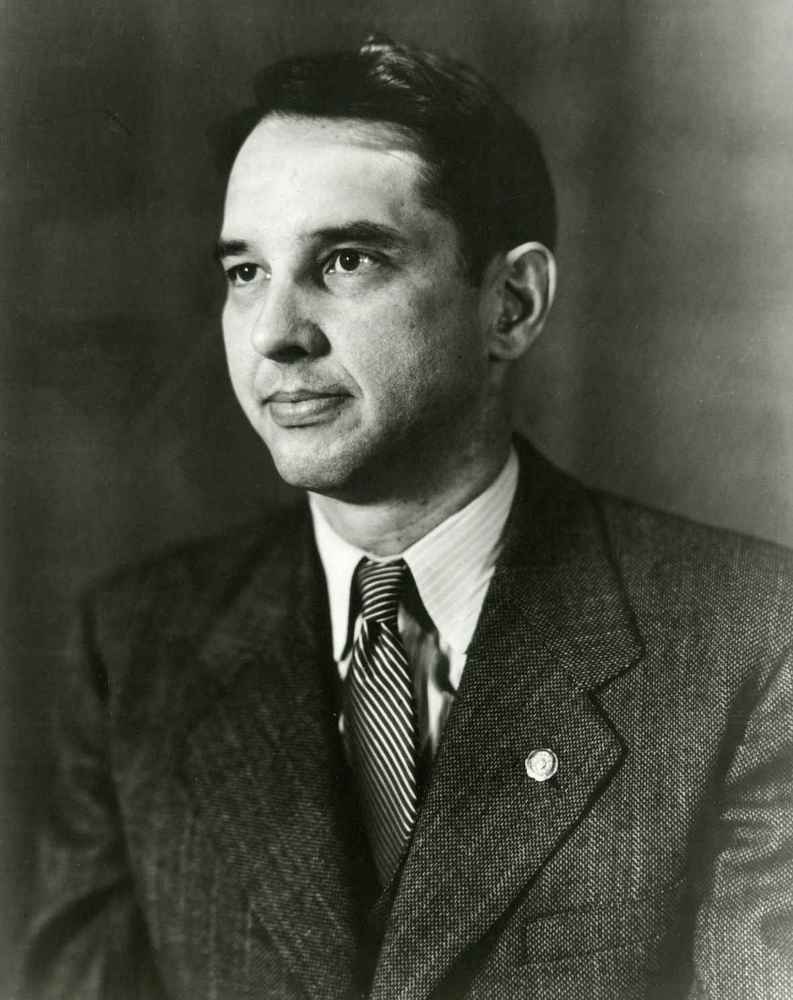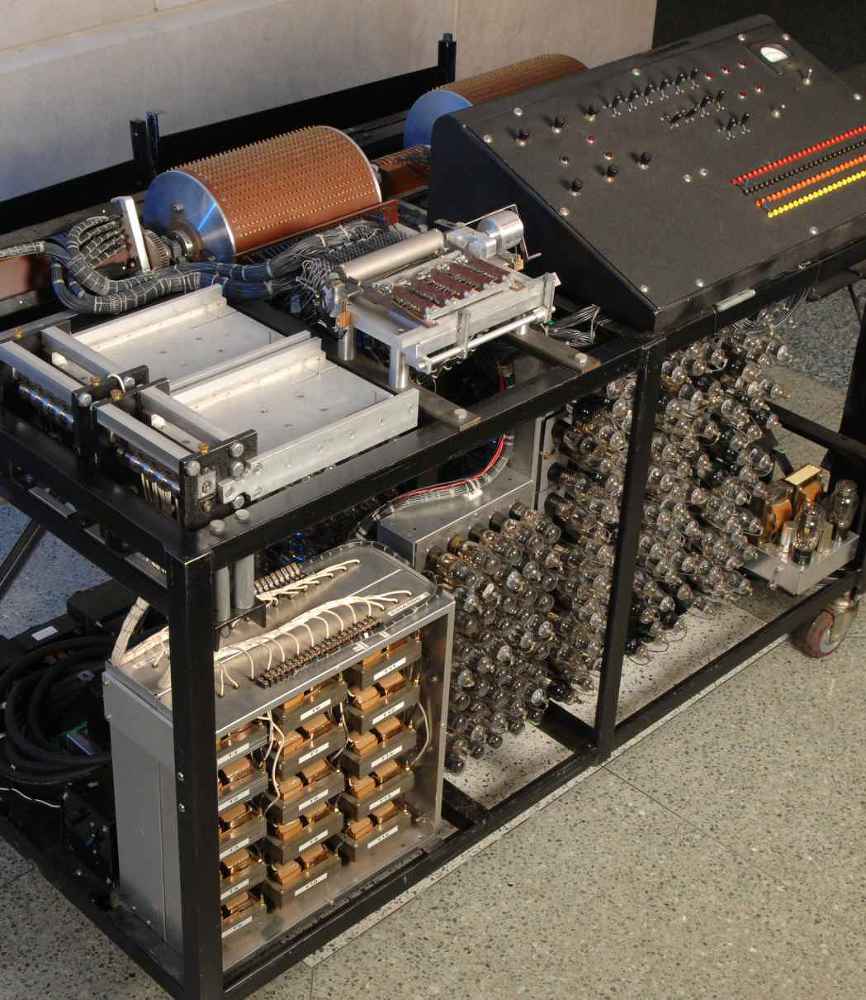
George Stibitz (1904–95) circa 1945.

Konrad Zuse (1910–95) with the Z4 computer in 1944.

John Atanasoff (1903–95) at Iowa State, circa 1940.

Reconstruction of Atanasoff’s computer.
Once he had settled on the memory unit, Atanasoff turned his attention to how to construct the arithmetic and logic unit, which he called the “computing mechanism.” He decided it should be fully electronic; that meant using vacuum tubes, even though they were expensive. The tubes would act as on-off switches to perform the function of logic gates in a circuit that could add, subtract, and perform any Boolean function.
That raised a theoretical math issue of the type he had loved since he was a boy: Should his digital system be decimal or binary or rely on some other numerical base? A true enthusiast for number systems, Atanasoff explored many options. “For a short time the base one-hundred was thought to have some promise,” he wrote in an unpublished paper. “This same calculation showed that the base that theoretically gives the highest speed of calculation is e, the natural base.”31 But, balancing theory with practicality, he finally settled on base-2, the binary system. By late 1937, these and other ideas were jangling around in his head, a “hodgepodge” of concepts that wouldn’t “jell.”
Atanasoff loved cars; he liked to buy, if he could, a new one each year, and in December 1937, he had a new Ford with a powerful V8 engine. To relax his mind, he took it for a late-night spin for what would become a noteworthy moment in the history of computing:
One night in the winter of 1937 my whole body was in torment from trying to solve the problems of the machine. I got in my car and drove at high speeds for a long while so I could control my emotions. It was my habit to do this for a few miles: I could gain control of myself by concentrating on driving. But that night I was excessively tormented, and I kept on going until I had crossed the Mississippi River into Illinois and was 189 miles from where I started.32
He turned off the highway and pulled into a roadhouse tavern. At least in Illinois, unlike in Iowa, he could buy a drink, and he ordered himself a bourbon and soda, then another. “I realized that I was no longer so nervous and my thoughts turned again to computing machines,” he recalled. “I don’t know why my mind worked then when it had not worked previously, but things seemed to be good and cool and quiet.” The waitress was inattentive, so Atanasoff got to process his problem undisturbed.33
He sketched out his ideas on a paper napkin, then began to sort through some practical questions. The most important was how to replenish the charges in the condensers, which would otherwise drain after a minute or two. He came up with the idea of putting them on rotating cylinder drums, about the size of 46-ounce cans of V8 juice, so they would come into contact once a second with brushlike wires and have their charges refreshed. “During this evening in the tavern, I generated within my mind the possibility of the regenerative memory,” he declared. “I called it ‘jogging’ at that time.” With each turn of the rotating cylinder, the wires would jog the memory of the condensers and, when necessary, retrieve data from the condensers and store new data. He also came up with an architecture that would take numbers from two different cylinders of condensers, then use the vacuum-tube circuit to add or subtract them and put the result into memory. After a few hours of figuring everything out, he recalled, “I got in my car and drove home at a slower rate.”34
By May 1939, Atanasoff was ready to begin construction of a prototype. He needed an assistant, preferably a graduate student with engineering experience. “I have your man,” a friend on the faculty told him one day. Thus he struck up a partnership with another son of a self-taught electrical engineer, Clifford Berry.35
The machine was designed and hard-wired with a single purpose: solving simultaneous linear equations. It could handle up to twenty-nine variables. With each step, Atanasoff’s machine would process two equations and eliminate one of the variables, then print the resulting equations on 8 x 11 binary punch cards. This set of cards with the simpler equation would then be fed back into the machine for the process to begin anew, eliminating yet another variable. The process required a bit of time. The machine would (if they could get it to work properly) take almost a week to complete a set of twenty-nine equations. Still, humans doing the same process on desk calculators would require at least ten weeks.
Atanasoff demonstrated a prototype at the end of 1939 and, hoping to get funding to build a full-scale machine, typed up a thirty-five-page proposal, using carbon paper to make a few copies. “It is the main purpose of this paper to present a description and exposition of a computing machine which has been designed principally for the solution of large systems of linear algebraic equations,” he began. As if to fend off criticism that this was a limited purpose for a big machine, Atanasoff specified a long list of problems that required solving such equations: “curve fitting . . . vibrational problems . . . electrical circuit analysis . . . elastic structures.” He concluded with a detailed list of proposed expenditures, which added up to the grand sum of $5,330, which he ended up getting from a private foundation.36 Then he sent one of the carbon copies of his proposal to a Chicago patent lawyer retained by Iowa State, who, in a dereliction of duty that would spawn decades of historical and legal controversy, never got around to filing for any patents.
By September 1942 Atanasoff’s full-scale model was almost finished. It was the size of a desk and contained close to three hundred vacuum tubes. There was, however, a problem: the mechanism for using sparks to burn holes in the punch cards never worked properly, and there were no teams of machinists and engineers at Iowa State he could turn to for help.
At that point, work stopped. Atanasoff was drafted into the Navy and sent to its ordnance laboratory in Washington, DC, where he worked on acoustic mines and later attended the atomic bomb tests at Bikini Atoll. Shifting his focus from computers to ordnance engineering, he remained an inventor, earning thirty patents, including on a minesweeping device. But his Chicago lawyer never applied for patents on his computer.
Atanasoff’s computer could have been an important milestone, but it was, both literally and figuratively, relegated to the dustbin of history. The almost-working machine was put into storage in the basement of the physics building at Iowa State, and a few years later no one seemed to remember what it did. When the space was needed for other uses in 1948, a graduate student dismantled it, not realizing what it was, and discarded most of the parts.37 Many early histories of the computer age do not even mention Atanasoff.
Even if it had worked properly, his machine had limitations. The vacuum-tube circuit made lightning-fast calculations, but the mechanically rotated memory units slowed down the process enormously. So did the system for burning holes in the punch cards, even when it worked. In order to be truly fast, modern computers would have to be all-electronic, not just partly. Nor was Atanasoff’s model programmable. It was geared to do just one thing: solve linear equations.